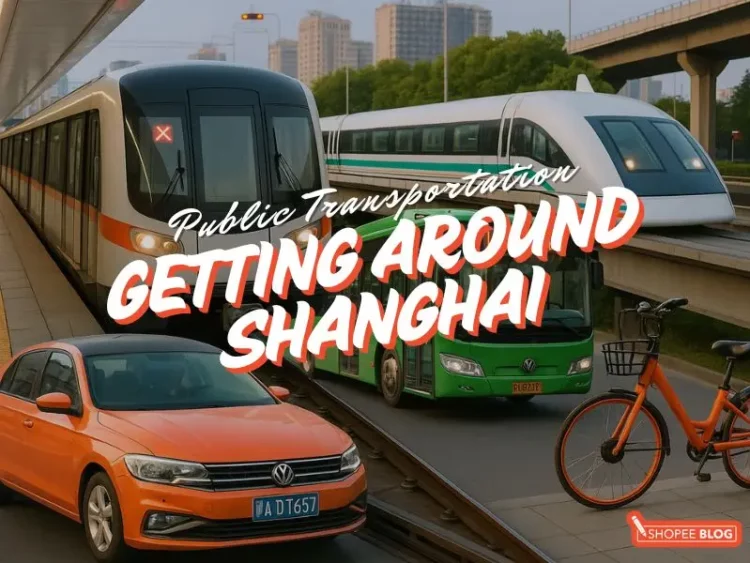Shanghai is massive – we’re talking over 24 million people in one city. As someone planning a trip there soon, I’ll admit the idea of navigating this sprawling metropolis initially felt daunting. The good news? Shanghai’s public transportation is extensive, efficient, and incredibly tourist-friendly. From ultra-modern trains to colourful taxis and even bicycles, there are plenty of ways to zip from point A to B in Shanghai.
In this guide, I’ll break down the main ways to get around Shanghai – Metro, Bus, Taxi, Maglev, and Bicycle – with handy tips I’ve gathered while prepping for my adventure. By the end, you (and I!) should feel ready to tackle Shanghai’s streets with confidence.
1. Metro
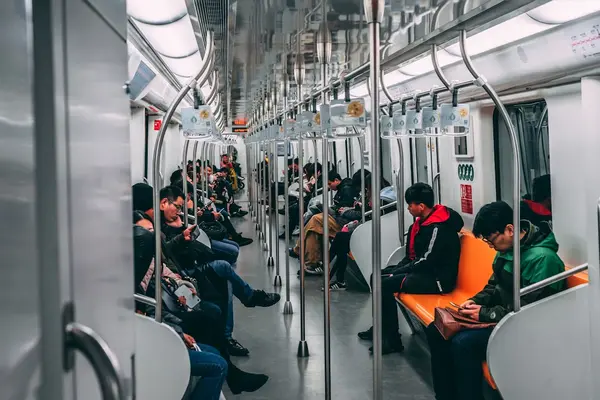
The Shanghai Metro is hands down the easiest and quickest way to get around the city. It’s one of the world’s busiest subway systems, with 19 lines and over 500 stations sprawling across all major areas. Don’t worry if you don’t speak Mandarin – stations have comprehensive colour-coded maps, and most signs and announcements are in both Chinese and English. My friends were relieved to learn they could find their way even as non-fluent Chinese speakers, since every stop name is shown in Pinyin too.
The Metro runs roughly 5.30am to 11.00pm daily, with trains every 3 – 7 minutes. A single ride costs between ¥3 and ¥15 (SGD0.50 -3), depending on the distance! You can buy single-journey tokens at multilingual machines, but most locals use a Shanghai Public Transport Card or scan a phone app to pay.
Tip for riding the metro:
- Avoid rush hours if you can (around 7- 9am and 5 – 7pm)
- Use mobile payment apps like Alipay or WeChat Pay to scan the QR code at the gate
- Otherwise, you can also consider a tourist pass: one-day unlimited metro travel for ¥18 (SGD3.23), or a three-day pass for ¥45 (SGD8) – perfect if you’ll be sightseeing non-stop
2. Bus
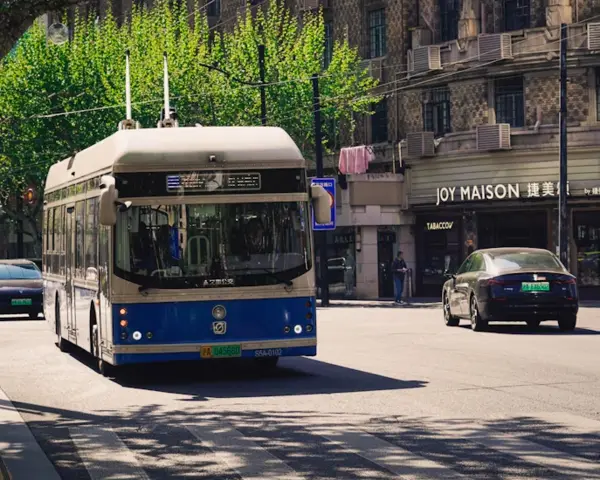
Now, buses can be a bit trickier for tourists than the metro. Most bus stop signs are in Chinese only, so unless your Mandarin reading skills are ace, you’ll want to plan your route ahead of time. I’m definitely saving the bus routes I need in a translation app or taking photos of the Chinese characters for my destination. The good news is that once on board, stop announcements are also made in English on many buses! Buses can also get you closer to certain attractions than the metro, so they’re worth figuring out. Just double-check the bus number and endpoint so you don’t hop on the right bus going the wrong direction (been there, done that 😅).
Tips for riding the bus:
- If you’re paying by cash, be sure to carry exact change, as drivers don’t give change
- If you’re unsure which bus to take, ask a hotel staff member or use a mapping app (more on those apps later) to find the right route
3. Taxi (and Ride-Hailing with DiDi)
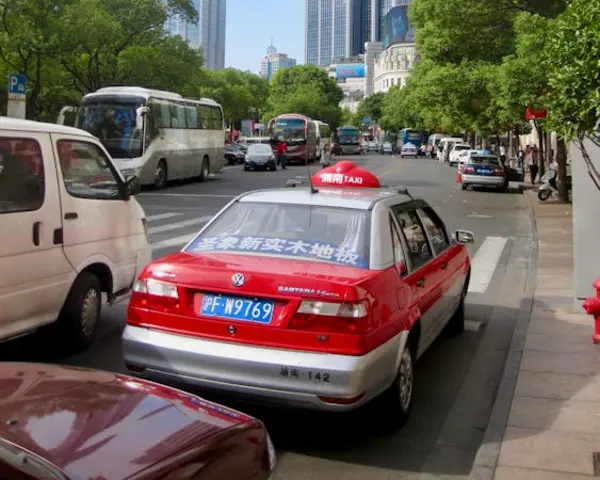
A fun fact I learned: Shanghai’s taxis are colour-coded by company. You’ll see blue, yellow, green, white, and more. The light-blue “Dazhong” taxis and yellow “Qiangsheng” taxis are among the most reputable, often seen queued at hotels. Dark red or maroon cabs (and any cab with an “X” on the license plate) tend to charge higher fares – something to keep in mind if you’re trying to save a few yuan.
If you can’t find an empty taxi on the street (rain, shift change, or busy areas make this tricky), this is where DiDi Chuxing comes to the rescue. Think of DiDi as the Grab (or Uber) of China – you can use the DiDi app in English to hail either a regular taxi or a private car. The app shows you upfront estimates, you can pay cashless via credit card, Alipay, or WeChat, and there’s even an in-app translation feature to chat with your driver if Mandarin isn’t your strong suit.
Tips for riding the taxi / DiDi:
- Avoid unlicensed “black cabs” that might approach you, especially around airports; if there’s no meter or no taxi sign, just say no
- Most taxi drivers in Shanghai do not speak much English, so a pro tip is to have your destination address written in Chinese
4. Maglev
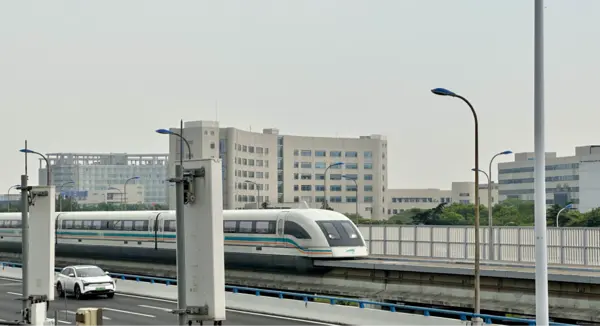
Okay, the Maglev is arguably not just public transportation in Shanghai – it’s an attraction in itself. This futuristic train connects Pudong International Airport with Longyang Road station on the edge of the city, a ~30 km journey that the Maglev zips through in a blistering 8 minutes. How? By levitating on magnets and hitting speeds up to 430 km/h (267 mph). Yes, you read that right. The Shanghai Maglev is the fastest commercial train in the world, and riding it feels like something out of a sci-fi movie.
The train departs roughly every 15 – 20 minutes between 6.45am and 9.40pm daily. You can buy tickets at the Maglev station in the airport – a single ride costs about ¥50 (around SGD10). By the time you reach Longyang Road station, you can transfer to the Metro (Line 2, among others) or grab a taxi/bus to your final destination – downtown Shanghai is still a bit further, since the Maglev doesn’t go into the city centre.
Is the Maglev worth it? I’d say yes for the experience alone.
Tips for riding the Maglev:
- Show your same-day flight boarding pass for a ¥10 (~SGD2) discount on your ride
- Grab the round-trip or combo ticket that includes a Metro Day Pass if you plan to return via Maglev
5. Bicycle
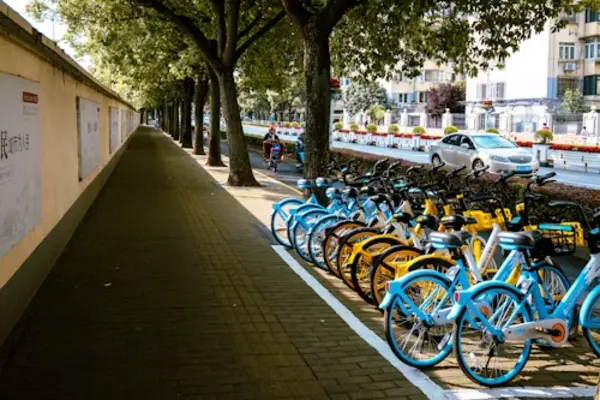
For a more down-to-earth way of getting around, why not join the locals and hop on a bicycle? Shanghai has embraced bike culture in a big way. You’ll see residents cycling to work or running errands daily. As a tourist, you have two main options: rent a bicycle from a shop or use the bike-sharing apps that are ubiquitous in Chinese cities.
Traditional rentals cost around ¥80 – ¥150 (SGD14 – 26) per day and can be found at various rental shops (especially near parks or tourist hotspots). However, the bike-share route is super convenient if you have mobile internet. Apps like Mobike (now part of Meituan) or Ofo allow you to unlock bikes scattered all over the city. These apps have English interfaces and cost roughly ¥1 (SGD0.20) per half-hour of riding. It’s as easy as find, scan, and go – you pick up a bike wherever it’s parked and just leave it at your destination (well, preferably in a designated bike parking area or out of the way).
Tips for riding the bicycle:
- A word of caution: Shanghai’s traffic can be intense, and not every road is bicycle-friendly. Many main roads have dedicated bike lanes, but some major avenues ban bicycles altogether
- If you’re cycling, stick to bike lanes and smaller streets, and stay alert
Must-have apps for getting around Shanghai
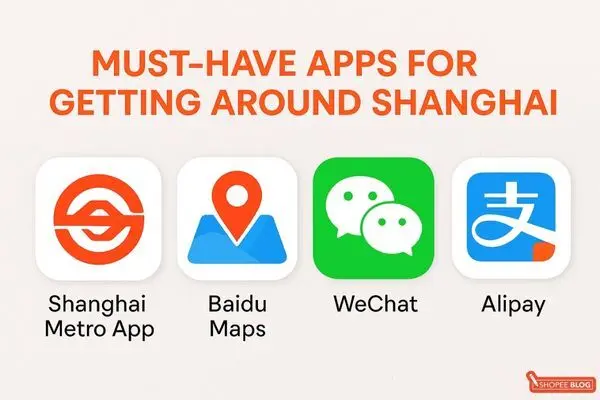
In today’s connected world, your smartphone can be your best friend in Shanghai. I’ve stocked mine with a few must-have China apps to make getting around Shanghai’s public transportation a breeze:
-
Shanghai Metro App (Metro Man/Metro 上海)
To navigate the metro like a boss, a metro map app is essential. I downloaded MetroMan, a highly recommended app that works offline and provides real-time train schedules, routes, and fares. It’s in English and super intuitive – type in your departure and destination stations, and it will figure out the quickest route, transfers, and even tell you which exit to use. Alternatively, apps like Citymapper also cover Shanghai and can integrate metro, bus, and walking directions in one go.
-
Baidu Maps (百度地图)
Google Maps’ coverage in China is limited (and Google services are blocked on cellular networks), so Baidu Maps is the go-to for navigation. Baidu Maps has very detailed and accurate info for buses, walking, and driving. The catch: it’s primarily in Chinese. However, with a bit of effort (and perhaps copy-pasting addresses), it’s doable – plus, it shows public transport options that western apps might miss. There is an English mode in the app settings, though some place names might still display in Chinese. I see this as my backup for complex journeys. Another alternative is Apple Maps, which surprisingly works decently in China nowadays, or AMap (Gaode), which has an English version too.
-
WeChat (微信)
It’s impossible to talk about China without mentioning WeChat. This all-in-one app is like WhatsApp, Facebook, and PayPal rolled into one. For transport, WeChat Pay is especially useful – you can pay for metro rides, buses, taxis, and pretty much anything by scanning QR codes. I plan to link my credit card via WeChat’s wallet (foreign cards can be added, though some features are easier with a Chinese bank card). Many vending machines, convenience stores and even street food stalls in Shanghai prefer mobile payment, so WeChat Pay will be my everyday tool.
-
Alipay (支付宝)
Another mobile payment giant. Much like WeChat Pay, Alipay is widely accepted everywhere – from big malls to tiny dumpling shops. As a tourist, Alipay has a feature called Tour Pass that lets foreigners use a prepaid wallet linked to their international bank card. I’ve set this up to ensure I have multiple cashless options.
Getting around Shanghai made easy
Getting around Shanghai might have seemed intimidating at first, but with all these options and tips, I’m feeling much more confident about my upcoming trip – and I hope you are too. The city’s blend of ultra-modern infrastructure and local charm means you can whiz across town on a high-speed train in the morning, then meander through old alleys on a bicycle in the afternoon. The key is to mix and match transport modes to fit your plans. To further smooth out your trip, check out some of our other guides, like things to do in Shanghai, a ready-made Shanghai Itinerary for inspiration, and even a Shanghai shopping guide!

